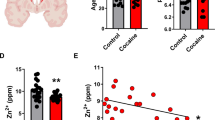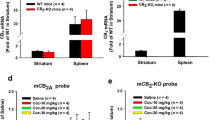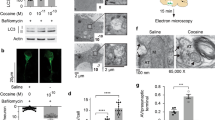Abstract
The potential involvement of the cannabinoid CB2 receptors (CB2r) in the adaptive responses induced by cocaine was studied in transgenic mice overexpressing the CB2r (CB2xP) and in wild-type (WT) littermates. For this purpose, the acute and sensitized locomotor responses to cocaine, conditioned place preference, and cocaine intravenous self-administration were evaluated. In addition, we assessed whether CB2r were localized in neurons and/or astrocytes, and whether they colocalized with dopamine D1 and D2 receptors (D1Dr and D2Dr). Dopamine (DA) extracellular levels in the nucleus accumbens (NAcc), and gene expression of tyrosine hydroxylase (TH) and DA transporter (DAT) in the ventral tegmental area (VTA), and μ-opioid and cannabinoid CB1 receptors in the NAcc were also studied in both genotypes. CB2xP mice showed decreased motor response to acute administration of cocaine (10–20 mg/kg) and cocaine-induced motor sensitization compared with WT mice. CB2xP mice presented cocaine-induced conditioned place aversion and self-administered less cocaine than WT mice. CB2r were found in neurons and astrocytes and colocalized with D2Dr in the VTA and NAcc. No significant differences in extracellular DA levels in the NAcc were observed between genotypes after cocaine administration. Under baseline conditions, TH and DAT gene expression was higher and μ-opioid receptor gene expression was lower in CB2xP than in WT mice. However, both genotypes showed similar changes in TH and μ-opioid receptor gene expression after cocaine challenge independently of the pretreatment received. Importantly, the cocaine challenge decreased DAT gene expression to a lesser extent in cocaine-pretreated CB2xP than in cocaine-pretreated WT mice. These results revealed that CB2r are involved in cocaine motor responses and cocaine self-administration, suggesting that this receptor could represent a promising target to develop novel treatments for cocaine addiction.
Similar content being viewed by others

Log in or create a free account to read this content
Gain free access to this article, as well as selected content from this journal and more on nature.com
or
References
Andre VM, Cepeda C, Cummings DM, Jocoy EL, Fisher YE, William Yang X et al (2010). Dopamine modulation of excitatory currents in the striatum is dictated by the expression of D1 or D2 receptors and modified by endocannabinoids. Eur J Neurosci 31: 14–28.
Corbille AG, Valjent E, Marsicano G, Ledent C, Lutz B, Herve D et al (2007). Role of cannabinoid type 1 receptors in locomotor activity and striatal signaling in response to psychostimulants. J Neurosci 27: 6937–6947.
Cossu G, Ledent C, Fattore L, Imperato A, Bohme GA, Parmentier M et al (2001). Cannabinoid CB1 receptor knockout mice fail to self-administer morphine but not other drugs of abuse. Behav Brain Res 118: 61–65.
Chefer VI, Kieffer BL, Shippenberg TS (2004). Contrasting effects of mu opioid receptor and delta opioid receptor deletion upon the behavioral and neurochemical effects of cocaine. Neuroscience 127: 497–503.
De Vries TJ, Shaham Y, Homberg JR, Crombag H, Schuurman K, Dieben J et al (2001). A cannabinoid mechanism in relapse to cocaine seeking. Nat Med 7: 1151–1154.
Di Chiara G (1995). The role of dopamine in drug abuse viewed from the perspective of its role in motivation. Drug Alcohol Depend 38: 95–137.
Diana M, Melis M, Muntoni AL, Gessa GL (1998). Mesolimbic dopaminergic decline after cannabinoid withdrawal. Proc Natl Acad Sci USA 95: 10269–10273.
Ehrhart J, Obregon D, Mori T, Hou H, Sun N, Bai Y et al (2005). Stimulation of cannabinoid receptor 2 (CB2) suppresses microglial activation. J Neuroinflammation 2: 29.
Fattore L, Fadda P, Fratta W (2007). Endocannabinoid regulation of relapse mechanisms. Pharmacol Res 56: 418–427.
Filip M, Golda A, Zaniewska M, McCreary AC, Nowak E, Kolasiewicz W et al (2006). Involvement of cannabinoid CB1 receptors in drug addiction: effects of rimonabant on behavioral responses induced by cocaine. Pharmacol Rep 58: 806–819.
Gainetdinov RR, Bohn LM, Sotnikova TD, Cyr M, Laakso A, Macrae AD et al (2003). Dopaminergic supersensitivity in G protein-coupled receptor kinase 6-deficient mice. Neuron 38: 291–303.
Galeote L, Maldonado R, Berrendero F (2008). Involvement of kappa/dynorphin system in the development of tolerance to nicotine-induced antinociception. J Neurochem 105: 1358–1368.
Garcia-Gutierrez MS, Manzanares J (2011). Overexpression of CB2 cannabinoid receptors decreased vulnerability to anxiety and impaired anxiolytic action of alprazolam in mice. J Psychopharmacol 25: 111–120.
Garcia-Gutierrez MS, Perez-Ortiz JM, Gutierrez-Adan A, Manzanares J (2010). Depression-resistant endophenotype in mice overexpressing cannabinoid CB(2) receptors. Br J Pharmacol 160: 1773–1784.
Gong JP, Onaivi ES, Ishiguro H, Liu QR, Tagliaferro PA, Brusco A et al (2006). Cannabinoid CB2 receptors: immunohistochemical localization in rat brain. Brain Res 1071: 10–23.
Guzman ML, Upchurch D, Grimes B, Howard DS, Rizzieri DA, Luger SM et al (2001). Expression of tumor-suppressor genes interferon regulatory factor 1 and death-associated protein kinase in primitive acute myelogenous leukemia cells. Blood 97: 2177–2179.
Hall FS, Goeb M, Li XF, Sora I, Uhl GR (2004). mu-Opioid receptor knockout mice display reduced cocaine conditioned place preference but enhanced sensitization of cocaine-induced locomotion. Brain Res Mol Brain Res 121: 123–130.
Hummel M, Ansonoff MA, Pintar JE, Unterwald EM (2004). Genetic and pharmacological manipulation of mu opioid receptors in mice reveals a differential effect on behavioral sensitization to cocaine. Neuroscience 125: 211–220.
Ibrahim MM, Deng H, Zvonok A, Cockayne DA, Kwan J, Mata HP et al (2003). Activation of CB2 cannabinoid receptors by AM1241 inhibits experimental neuropathic pain: pain inhibition by receptors not present in the CNS. Proc Natl Acad Sci USA 100: 10529–10533.
Ishiguro H, Iwasaki S, Teasenfitz L, Higuchi S, Horiuchi Y, Saito T et al (2007). Involvement of cannabinoid CB2 receptor in alcohol preference in mice and alcoholism in humans. Pharmacogenomics J 7: 380–385.
Jaber M, Dumartin B, Sagne C, Haycock JW, Roubert C, Giros B et al (1999). Differential regulation of tyrosine hydroxylase in the basal ganglia of mice lacking the dopamine transporter. Eur J Neurosci 11: 3499–3511.
Jaber M, Jones S, Giros B, Caron MG (1997). The dopamine transporter: a crucial component regulating dopamine transmission. Mov Disord 12: 629–633.
Jones SR, Gainetdinov RR, Jaber M, Giros B, Wightman RM, Caron MG (1998). Profound neuronal plasticity in response to inactivation of the dopamine transporter. Proc Natl Acad Sci USA 95: 4029–4034.
Koob GF, Bloom FE (1988). Cellular and molecular mechanisms of drug dependence. Science 242: 715–723.
Kuhar MJ, Ritz MC, Boja JW (1991). The dopamine hypothesis of the reinforcing properties of cocaine. Trends Neurosci 14: 299–302.
Lesscher HM, Hoogveld E, Burbach JP, van Ree JM, Gerrits MA (2005). Endogenous cannabinoids are not involved in cocaine reinforcement and development of cocaine-induced behavioural sensitization. Eur Neuropsychopharmacol 15: 31–37.
Livak KJ, Schmittgen TD (2001). Analysis of relative gene expression data using real-time quantitative PCR and the 2(-Delta Delta C(T)) Method. Methods 25: 402–408.
Lupica CR, Riegel AC, Hoffman AF (2004). Marijuana and cannabinoid regulation of brain reward circuits. Br J Pharmacol 143: 227–234.
Maldonado R, Valverde O, Berrendero F (2006). Involvement of the endocannabinoid system in drug addiction. Trends Neurosci 29: 225–232.
Manzanares J, Corchero J, Romero J, Fernandez-Ruiz JJ, Ramos JA, Fuentes JA (1999). Pharmacological and biochemical interactions between opioids and cannabinoids. Trends Pharmacol Sci 20: 287–294.
Martin M, Ledent C, Parmentier M, Maldonado R, Valverde O (2000). Cocaine, but not morphine, induces conditioned place preference and sensitization to locomotor responses in CB1 knockout mice. Eur J Neurosci 12: 4038–4046.
Miller LL, Ward SJ, Dykstra LA (2008). Chronic unpredictable stress enhances cocaine-conditioned place preference in type 1 cannabinoid receptor knockout mice. Behav Pharmacol 19: 575–581.
Morice E, Denis C, Giros B, Nosten-Bertrand M (2010). Evidence of long-term expression of behavioral sensitization to both cocaine and ethanol in dopamine transporter knockout mice. Psychopharmacology (Berl) 208: 57–66.
Navarro M, Carrera MR, Fratta W, Valverde O, Cossu G, Fattore L et al (2001). Functional interaction between opioid and cannabinoid receptors in drug self-administration. J Neurosci 21: 5344–5350.
Nestler EJ (2001). Molecular basis of long-term plasticity underlying addiction. Nat Rev Neurosci 2: 119–128.
Oliva JM, Ortiz S, Palomo T, Manzanares J (2003). Behavioural and gene transcription alterations induced by spontaneous cannabinoid withdrawal in mice. J Neurochem 85: 94–104.
Onaivi ES (2006). Neuropsychobiological evidence for the functional presence and expression of cannabinoid CB2 receptors in the brain. Neuropsychobiology 54: 231–246.
Onaivi ES (2008). An endocannabinoid hypothesis of drug reward and drug addiction. Ann N Y Acad Sci 1139: 412–421.
Onaivi ES, Ishiguro H, Gong JP, Patel S, Meozzi PA, Myers L et al (2008). Brain neuronal CB2 cannabinoid receptors in drug abuse and depression: from mice to human subjects. PLoS ONE 3: e1640.
Ortega-Alvaro A, Aracil-Fernandez A, Garcia-Gutierrez MS, Navarrete F, Manzanares J (2011). Deletion of CB2 cannabinoid receptor induces schizophrenia-related behaviors in mice. Neuropsychopharmacology 36: 1489–1504.
Paldyova E, Bereczki E, Santha M, Wenger T, Borsodi A, Benyhe S (2008). Noladin ether, a putative endocannabinoid, inhibits mu-opioid receptor activation via CB2 cannabinoid receptors. Neurochem Int 52: 321–328.
Palkovits M (1983). Punch sampling biopsy technique. Methods Enzymol 103: 368–376.
Parolaro D, Rubino T (2008). The role of the endogenous cannabinoid system in drug addiction. Drug News Perspect 21: 149–157.
Paxinos G, Franklin KBJ (2001). The Mouse Brain in Stereotaxic Coordinates. Academic Press, Harcourt Science and Technology Company: New York.
Pierce RC, Kalivas PW (1997). A circuitry model of the expression of behavioral sensitization to amphetamine-like psychostimulants. Brain Res Brain Res Rev 25: 192–216.
Racz I, Nadal X, Alferink J, Banos JE, Rehnelt J, Martin M et al (2008). Crucial role of CB(2) cannabinoid receptor in the regulation of central immune responses during neuropathic pain. J Neurosci 28: 12125–12135.
Robinson TE, Berridge KC (1993). The neural basis of drug craving: an incentive-sensitization theory of addiction. Brain Res Brain Res Rev 18: 247–291.
Robinson TE, Berridge KC (2001). Incentive-sensitization and addiction. Addiction 96: 103–114.
Robledo P, Mendizabal V, Ortuno J, de la Torre R, Kieffer BL, Maldonado R (2004). The rewarding properties of MDMA are preserved in mice lacking mu-opioid receptors. Eur J Neurosci 20: 853–858.
Rocha BA, Scearce-Levie K, Lucas JJ, Hiroi N, Castanon N, Crabbe JC et al (1998). Increased vulnerability to cocaine in mice lacking the serotonin-1B receptor. Nature 393: 175–178.
Seif T, Makriyannis A, Kunos G, Bonci A, Hopf FW (2011). The endocannabinoid 2-arachidonoylglycerol mediates D1 and D2 receptor cooperative enhancement of rat nucleus accumbens core neuron firing. Neuroscience 193: 21–33.
Sora I, Hall FS, Andrews AM, Itokawa M, Li XF, Wei HB et al (2001). Molecular mechanisms of cocaine reward: combined dopamine and serotonin transporter knockouts eliminate cocaine place preference. Proc Natl Acad Sci USA 98: 5300–5305.
Soria G, Mendizabal V, Tourino C, Robledo P, Ledent C, Parmentier M et al (2005). Lack of CB1 cannabinoid receptor impairs cocaine self-administration. Neuropsychopharmacology 30: 1670–1680.
Spanagel R, Weiss F (1999). The dopamine hypothesis of reward: past and current status. Trends Neurosci 22: 521–527.
Tanda G, Goldberg SR (2003). Cannabinoids: reward, dependence, and underlying neurochemical mechanisms--a review of recent preclinical data. Psychopharmacology (Berl) 169: 115–134.
Tanda G, Pontieri FE, Di Chiara G (1997). Cannabinoid and heroin activation of mesolimbic dopamine transmission by a common mu1 opioid receptor mechanism. Science 276: 2048–2050.
Trigo JM, Orejarena MJ, Maldonado R, Robledo P (2009). MDMA reinstates cocaine-seeking behaviour in mice. Eur Neuropsychopharmacol 19: 391–397.
Trigo JM, Renoir T, Lanfumey L, Hamon M, Lesch KP, Robledo P et al (2007). 3,4-methylenedioxymethamphetamine self-administration is abolished in serotonin transporter knockout mice. Biol Psychiatry 62: 669–679.
Urigüen L, Pérez-Rial S, Ledent C, Palomo T, Manzanares J (2004). Impaired action of anxiolytic drugs in mice deficient in cannabinoid CB1 receptors. Neuropharmacology 46: 966–973.
Van Sickle MD, Duncan M, Kingsley PJ, Mouihate A, Urbani P, Mackie K et al (2005). Identification and functional characterization of brainstem cannabinoid CB2 receptors. Science 310: 329–332.
Vanderschuren LJ, Kalivas PW (2000). Alterations in dopaminergic and glutamatergic transmission in the induction and expression of behavioral sensitization: a critical review of preclinical studies. Psychopharmacology (Berl) 151: 99–120.
Xi ZX, Peng XQ, Li X, Song R, Zhang HY, Liu QR et al (2011). Brain cannabinoid CB receptors modulate cocaine's actions in mice. Nature neuroscience 14: 1160–1166.
Xi ZX, Spiller K, Pak AC, Gilbert J, Dillon C, Li X et al (2008). Cannabinoid CB1 receptor antagonists attenuate cocaine's rewarding effects: experiments with self-administration and brain-stimulation reward in rats. Neuropsychopharmacology 33: 1735–1745.
Yoo JH, Yang EM, Lee SY, Loh HH, Ho IK, Jang CG (2003). Differential effects of morphine and cocaine on locomotor activity and sensitization in mu-opioid receptor knockout mice. Neurosci Lett 344: 37–40.
Acknowledgements
This research was supported by ‘Instituto de Salud Carlos III’ (RETICS, RD06/0001/1004), ‘Plan Nacional Sobre Drogas’ (PNSD 2007/061), Fundación para la Investigación en Salud Castilla La Mancha, FISCAM), and ‘Ministerio de Ciencia e Innovación’ (#SAF 2008-01106 and #SAF 2011-23420) to JM; by ‘Instituto de Salud Carlos III’ (RETICS, RD06/001/001), ‘Ministerio de Ciencia e Innovación’ (#SAF2007-64062), and Generalitat de Catalunya (#2009SGR00731 and the ICREA Academia award) to RM; and by the ‘Ministerio de Ciencia e Innovación’ (#SAF2009-10689) to PB Postdoctoral fellows AO-A and AT are supported by FISCAM, and JMT by ‘Becas para estancias cortas de especialización e investigación en psiquiatría y psicología de la infancia y adolescencia o en neurociencias’ Fundación Alicia Koplowitz. AA-F (predoctoral fellow) and Analía Rico (AR, technician) are supported by RETICS. MSG-G is a predoctoral fellow supported by ‘Ministerio de Ciencia e Innovación’. DN is a predoctoral FPI fellow. We thank AR for his excellent technical assistance, and Dulce Real for her contribution in the microdialysis and HPLC experiments. The partial support of FEDER funds (EU) is also acknowledged.
Author information
Authors and Affiliations
Corresponding author
Ethics declarations
Competing interests
The authors declare no conflict of interest.
Additional information
Supplementary Information accompanies the paper on the Neuropsychopharmacology website
Rights and permissions
About this article
Cite this article
Aracil-Fernández, A., Trigo, J., García-Gutiérrez, M. et al. Decreased Cocaine Motor Sensitization and Self-Administration in Mice Overexpressing Cannabinoid CB2 Receptors. Neuropsychopharmacol 37, 1749–1763 (2012). https://doi.org/10.1038/npp.2012.22
Received:
Revised:
Accepted:
Published:
Issue date:
DOI: https://doi.org/10.1038/npp.2012.22
Keywords
This article is cited by
-
Repeated cocaine administration upregulates CB2 receptor expression in striatal medium-spiny neurons that express dopamine D1 receptors in mice
Acta Pharmacologica Sinica (2022)
-
Beta-caryophyllene inhibits cocaine addiction-related behavior by activation of PPARα and PPARγ: repurposing a FDA-approved food additive for cocaine use disorder
Neuropsychopharmacology (2021)
-
Cannabidiol Modulates Behavioural and Gene Expression Alterations Induced by Spontaneous Cocaine Withdrawal
Neurotherapeutics (2021)
-
The roles of cannabinoid CB1 and CB2 receptors in cocaine-induced behavioral sensitization and conditioned place preference in mice
Psychopharmacology (2020)
-
Potential of Cannabinoid Receptor Ligands as Treatment for Substance Use Disorders
CNS Drugs (2019)


